Big Ideas Math Algebra 1 Student Journal 1st Edition Chapter 5 Solving Systems Of Linear Equations
Page 147 Essential Question Answer
Let’s consider a system of equations.
It is required to describe whether a system can have no solutions or infinitely many solutions.
Yes, a system of linear equations has no solution if the equations are inconsistent or the graph for the system has parallel lines.
A system has infinitely many solutions when it is consistent, and the graph for the system of equations coincides.
Yes, a system of linear equations can have no solution or infinitely many solutions.

Page 147 Exercise 2 Answer
Given: We are given the number of small and large beads in a necklace and a bracelet. We know the weight of the necklace and the bracelet.
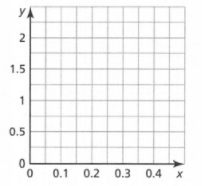
To find We have to write a system of linear equations that represents the situation.
We will assume “x” is the weight (in grams) of a small bead and “y” is the weight (in grams) of a large bead.
Then we will multiply the number with their corresponding weight and get the equation.
Read and Learn More Big Ideas Math Algebra 1 Student Journal 1st Edition Solutions
“x” is the weight (in grams) of a small bead and “y” is the weight (in grams) of a large bead
The equation that represents the weight of the necklace is: 40x + 6y = 10
The equation that represents the weight of the bracelet is: 20x + 3y = 5
The system of equations that represent the given scenario is
⇒ 40x + 6y = 10
⇒ 20x + 3y = 5
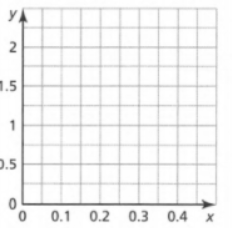
Given: We are given the number of small and large beads in a necklace and a bracelet. We know the weight of the necklace and the bracelet.
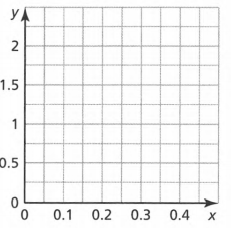
To find We have to graph the system in the coordinate plane and describe the two lines.
We will plot these graphs and check whether these lines are parallel or perpendicular or neither.
The system of equations is :
⇒ 40x + 6y = 10
⇒ 20x + 3y = 5
The plot of the system of equations is given below:
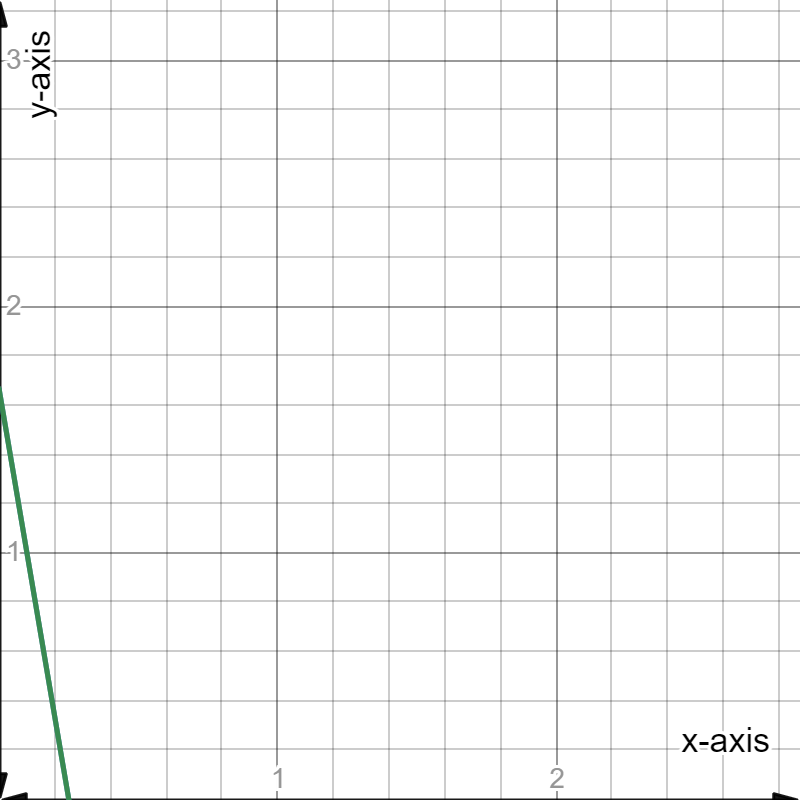
The plot of these two equations is coincident.
They can be represented by the same line as shown above in the graph.
The plot of the system of equations is
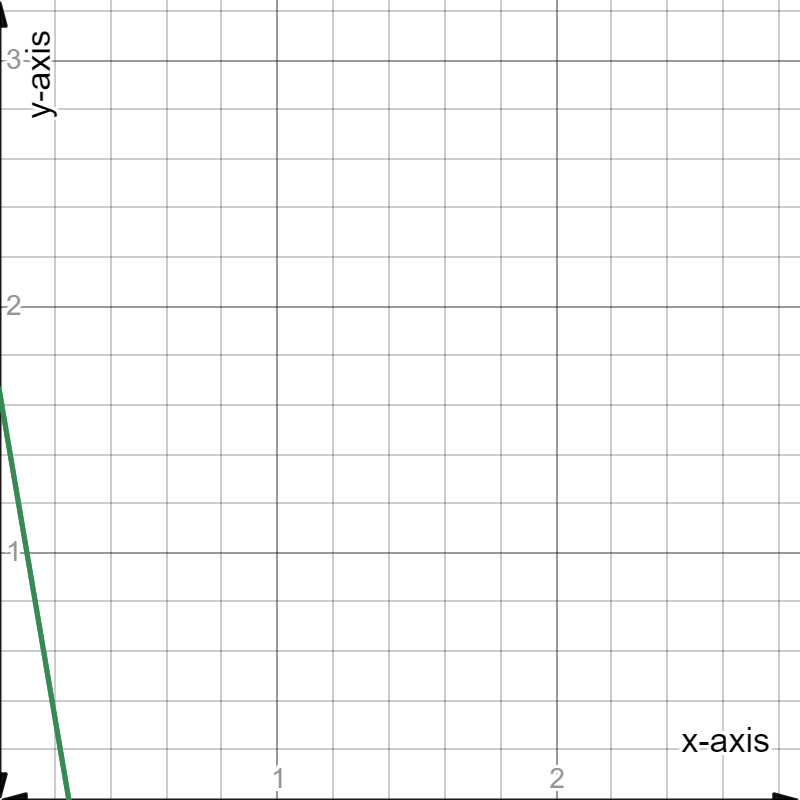
The two lines are coincidental.
Given: We are given the number of small and large beads in a necklace and a bracelet. We know the weight of the necklace and the bracelet.
To find We have to tell whether we can find the weight of each type of bead.
Now We calculate the weight of each bead by solving the system of equations.
We have made the system of equations in terms of the weight of each bead.
So when we solve them we can easily get to know the weight of each bead.
We can find the weight of each bead by solving the system of equations.
There are two equations and there are two variables in the equations. So, we can solve these equations for the values of “x” and “y”.
Big Ideas Math Algebra 1 Chapter 5 Exercise 5.4 Solutions
Big Ideas Math Algebra 1 Student Journal 1st Edition Chapter 5 Solving Systems Of Linear Equations Exercise 5.4 Page 148 Exercise 3 Answer
Given: A system of linear equations.
To find We have to tell whether a system of linear equations can have no solution and infinitely many solutions.
A system of equations can have a unique solution, no solution, or infinitely many solutions.
We get to know about the solution of a system of equations by looking at the coefficient of variables and the constant part.
An example of a system of equations with no solution:
⇒ 2x + 3y = 10
⇒ 2x + 3y = 12
The coefficients of “x” and “y” are the same but the constants in both the equations are different. So, this system will have no solution.
An example of a system of equations with infinitely many solutions:
⇒ 2x + 3y=6
⇒ 4x + 6y=12
The coefficients of “x” and “y” and the constant are proportional. So, they basically represent the same line on the graph. They have infinitely many solutions.
Yes, a linear system of equations has no solution or infinitely many solutions. The example of no solution is 2x + 3y = 10, 2x + 3y = 12. The example of infinitely many solutions is 2x + 3y = 6, 4x + 6y = 12.
Page 150 Exercise 2 Answer
Given: A system of equations is given to us. It is, y = 5x−1 y = −5x + 5
To findWe have to solve the given system.
We will use the elimination or the substitution method and get the value of variables.
The given system of equations is:
y = 5x−1——-(1)
y =−5x + 5——(2)
After adding them, we get
⇒ 2y = 5x−5x−1 + 5
⇒ 2y = 4
⇒ y = 2
Putting y=2 in equation (1) we get
⇒ 2 = 5x−1
⇒ 3 = 5x
⇒ x\(=\frac{3}{5}\)
The solution of the given system of equations y=5x−1,y=−5x+5 is x\(=\frac{3}{5}\) y=2.
Big Ideas Math Algebra 1 Student Journal 1st Edition Chapter 5 Solving Systems Of Linear Equations Exercise 5.4 Page 150 Exercise 3 Answer
Given: A system of equations is given to us. It is 2x−3y = 10, −2x + 3y = −10
To find We have to solve the given system.
We will use the elimination or the substitution method and get the value of variables.
The given system of equations is:
2x−3y = 10——-(1)
−2x+3y = −10——(2)
After adding, Equation (1) and Equation (2), we get
⇒ 2x−2x−3y + 3y = 10−10
⇒ 0 = 0
This is true, so the given system of equations has infinitely many solutions.
The given system of equations 2x−3y = 10,−2x+3y = −10, has infinitely many solutions.
Page 150 Exercise 4 Answer
Given: A system of equations is given to us. It is x + 3y = 6, −x−3y = 3
To find We have to solve the given system.
We will use the elimination or the substitution method and get the value of variables.
The given system of equations is:
x+3y = 6——(1)
−x−3y = 3—–(2)
After adding Equation (1) and Equation (2), we get
⇒ x−x + 3y−3y = 6 + 3
⇒ 0 = 9
This is not true, so the solution of the given system of equations does not exist.
The solution of the given system of equations x + 3y = 6,−x−3y = 3, does not exist.
Solving Systems Of Equations Exercise 5.4 Answers
Big Ideas Math Algebra 1 Student Journal 1st Edition Chapter 5 Solving Systems Of Linear Equations Exercise 5.4Page 150 Exercise 5 Answer
Given: A system of equations is given to us. It is 6x + 6y = −3, −6x−6y = 3
To find We have to solve the given system.
We will use the elimination or the substitution method and get the value of variables.
The given system of equations is:
6x + 6y = −3——(1)
−6x−6y = 3——-(2)
After adding Equation (1) and Equation (2), we get
⇒ 6x−6x + 6y−6y = −3 + 3
⇒ 0 = 0
This is true, so the given system of equations has infinitely many solutions.
The given system of equations has infinitely many solutions.
Page 150 Exercise 6 Answer
Given: A system of equations is given to us. It is 2x−5y =−3, 3x + 5y = 8
To find: We have to solve the given system.
We will use the elimination or the substitution method and get the value of variables.
The given system of equations is:
2x−5y=−3——(1)
3x+5y=8——–(2)
After adding Equation (1) and Equation (2), we get
⇒ 2x + 3x−5y + 5y =−3+8
⇒ 5x = 5
⇒ x = 1
Putting x = 1 in Equation (1) we get
2x−5y=−3
⇒ 2×1−5y = −3
⇒ 2 + 3 = 5y
⇒ 5y = 5
⇒ y = 1
The solution of the given system of equations 2x−5y = −3, 3x + 5y = 8 is x = 1,y = 1.
Page 150 Exercise 7 Answer
Given: A system of equations is given to us. It is 2x+3y=1, −2x+3y=−7
To find We have to solve the given system.
We will use the elimination or the substitution method and get the value of variables.
The given system of equations is:
2x+3y=1——–(1)
−2x+3y=−7—–(2)
After adding Equation (1) and Equation (2) we get
⇒ 2x−2x + 3y + 3y = 1−7
⇒ 6y = −6
⇒ y =−1
Putting y =−1 in equation (1), we get
2x + 3y = 1
⇒ 2x+3×−1 = 1
⇒ 2x−3 = 1
⇒ 2x = 4
⇒ x = 2
The solution of the given system of equations 2x+3y = 1,−2x + 3y = −7 is x = 2,y =−1.
Big Ideas Math Algebra 1 Student Journal 1st Edition Chapter 5 Solving Systems Of Linear Equations Exercise 5.4 Page 150 Exercise 8 Answer
A system of equations is given to us. It is 4x + 3y = 17, −8x−6y = 34
To find We have to solve the given system.
We will use the elimination or the substitution method and get the value of variables.4x+3y=17 −8x−6y=34
The given system of equations is:
4x+3y=17——(1)
−8x−6y=34—–(2)
Multiplying the equation (1) by 2, we get
⇒ 8x + 6y = 34
⇒ −8x − 6y = 34
After adding equation (1) and equation (2), we get
⇒ 8x−8x + 6y−6y = 34 + 34
⇒ 0 = 68
This is not true, so the solution of the given system of equations does not exist.
The solution of the given system of equations 4x + 3y = 17,−8x−6y = 34 does not exist.
Page 151 Exercise 10 Answer
Given: A system of equations is given to us. It is −2x + 5y = −21, 2x−5y = 21
To find: We have to solve the given system.
We will use the elimination or the substitution method and get the value of variables
The given system of equations is:
⇒ −2x + 5y = −21———(1)
⇒ 2x−5y = 21————-(2)
After adding them, we get
⇒ −2x + 2x + 5y−5y = −21 + 21
⇒ 0 = 0
This is true, so the given system of equations has infinitely many solutions.
The given system of equations −2x + 5y = −21,2x−5y = 21 has infinitely many solutions.
Page 151 Exercise 11 Answer
Given: A system of equations is given to us. It is 3x−8y = 3, 8x−3y = 8
To find We have to solve the given system.
We will use the elimination or the substitution method and get the value of variables.
The given system of equations is:
3x−8y = 3———(1)
8x−3y = 8———(2)
After adding equation (1) and equation (2), we get
⇒ 3x + 8x−8y−3y = 3 + 8
⇒ 11x−11y = 11
⇒ x−y = 1
After subtracting equation (1) and equation (2), we get
⇒ 3x−8x−8y + 3y = 3−8
⇒ −5x−5y = −5
⇒ x + y = 1
The system of equations is:
⇒ x−y = 1——–(3)
⇒ x + y = 1——–(4)
After adding equation (3) and equation (4), we get
⇒ x + x−y + y = 1 + 1
⇒ 2x = 2
⇒ x = 1
Putting x=1 in equation (1), we get
⇒ (3) 1−y=1
⇒ 0=y
The solution of the given system of equations 3x−8y = 3,8x−3y = 8 is x = 1,y = 0.
Big Ideas Math Student Journal Exercise 5.4 Explained
Big Ideas Math Algebra 1 Student Journal 1st Edition Chapter 5 Solving Systems Of Linear Equations Exercise 5.4 Page 151 Exercise 12 Answer
Given: A system of equations is given to us. It is 18x + 12y = 24, 3x + 2y = 6
To find We have to solve the given system.
We will use the elimination or the substitution method and get the value of variables.
The given system of equations is:
18x + 12y = 24——–(1)
3x + 2y=6———-(2)
Multiplying the equation (2) by 6, we get
⇒ 18x + 12y = 24
⇒ 18x + 12y = 36
After subtracting equation (1) and equation (2), we get
⇒ 18x−18x + 12y−12y = 24−36
⇒ 0 = −12
This is not true, so the solution of the given system of equations does not exist.
The solution of the given system of equations 18x+12y=24,3x+2y=6 does not exist.
Page 151 Exercise 14 Answer
Given: The given linear equations are:−3x−5y=8, 6x+10y=−16.
To Find The given equations are to be solved with the respective variables.
Solution: The methods of substitution and elimination are two ways any linear equation can be solved.
The given equations are:
−3x−5y = 8 6x + 10y =−16 ,with two variables x & y.
This could be solved by the elimination method wherein equation −3x−5y = 8 will be multiplied by 2 to get solved.
This gives us the equation −6x−10y = 16, which is added to the equation 6x + 10y =−16, which cancels all the terms giving us no solution.
The graph below also shows that there exists no solution as the equations plotted shows the same line:
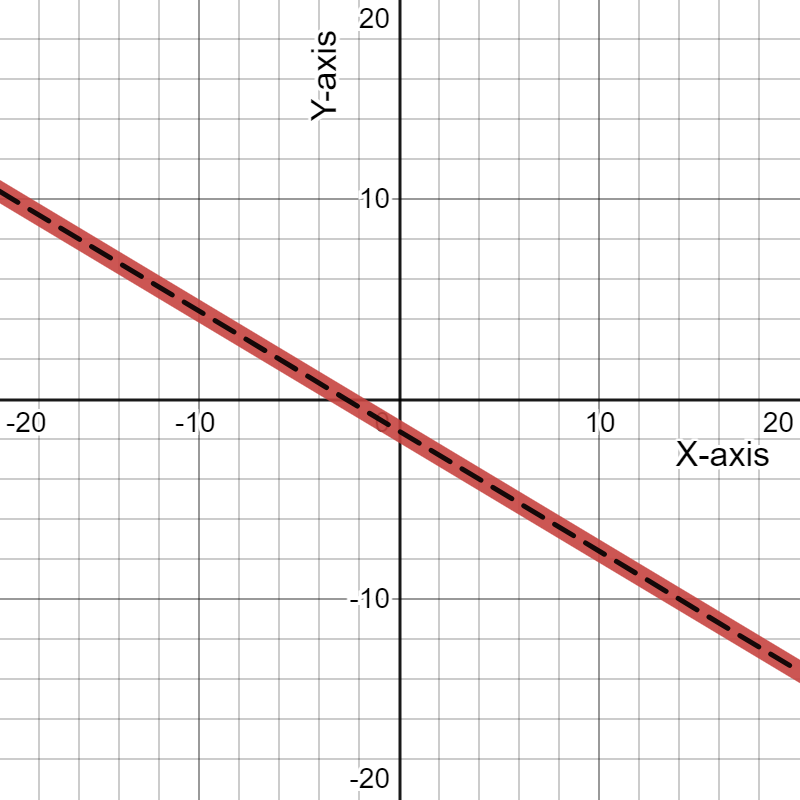
Solving the given equations −3x−5y = 8,6x + 10y = −16 we get that there exists no solution which is also proved by the graph below:
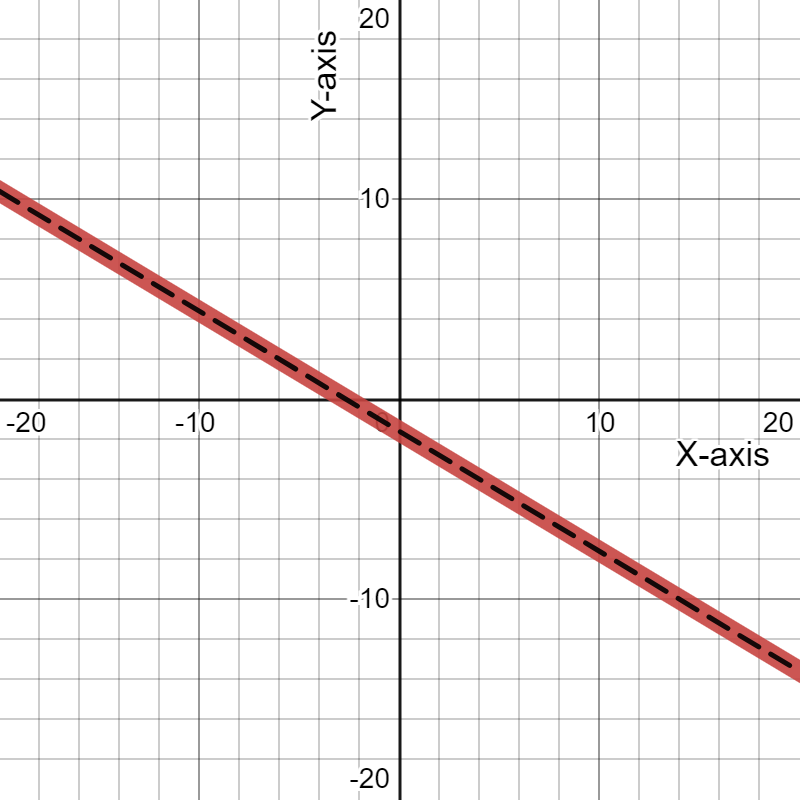
Page 151 Exercise 16 Answer
Given: The linear equations given are 5x + 7y = 7 7x + 5y = 5.
To Find The equations are to be solved with respect to the variables x & y.
Solution: This can be solved by the estimation method and the graph.
The given equations are :
5x + 7y = 7 7x + 5y = 5 which are solved with respect to the variables x & y.
Multiplying the equation 5x + 7y =7 by 7 and 7x + 5y = 5 by 5 and subtracting them we get 35x + 49y = 49, −35x−25y = −25.
By solving that we get the values of x & y as 0,1.
The graph below also shows the solution as
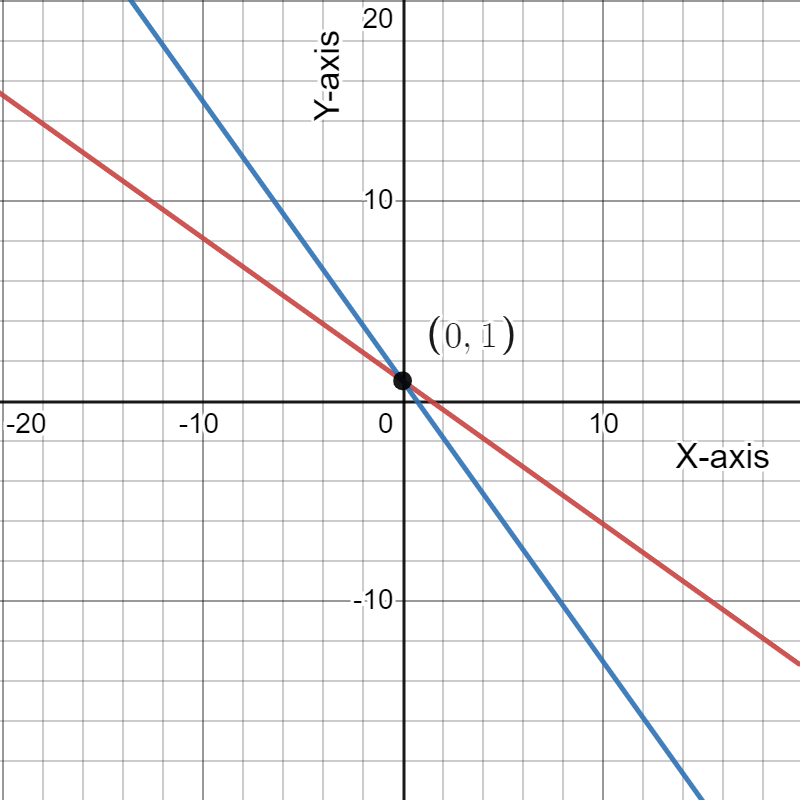
The equations 5x + 7y = 7,7x+5y = 5 solved gives the values x = 0 & y = 1 , which is shown in the graph below:
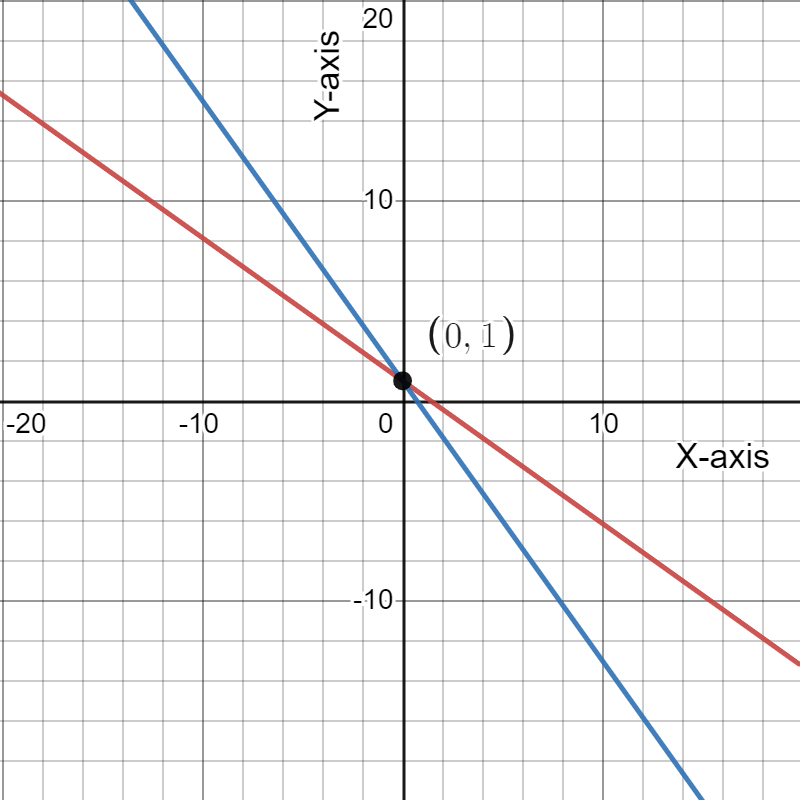
Chapter 5 Exercise 5.4 Solving Systems Practice
Page 151 Exercise 17 Answer
Given: The equation given is y=\(\frac{2}{3} x+7\), y=\(\frac{2}{3} x-5\).
To Find We need to find the values of x & y.
Solution: Solving these equations we get the values of variables shown by the graph.
The equations are rewritten as 3y−2x = 21 and 3y−2x =−15.
This is solved wherein we get no solution with respect to the variables.
The graph is shown below
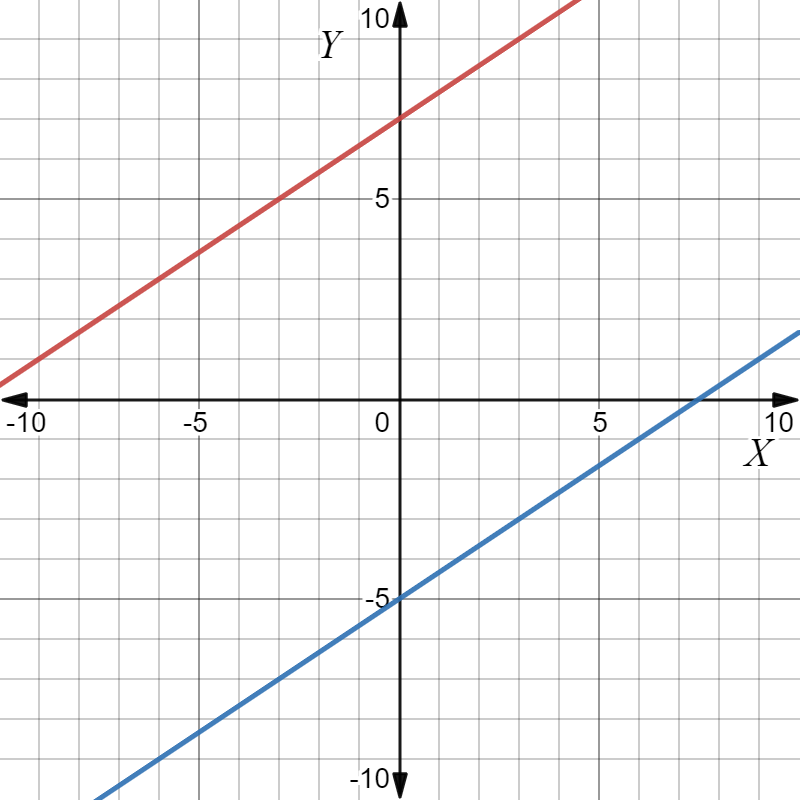
The graph shows two parallel lines with no solution.
The solution of they=\(\frac{2}{3} x+7\), y=\(\frac{2}{3} x-5\) equations are no solution also shown in the graph below:
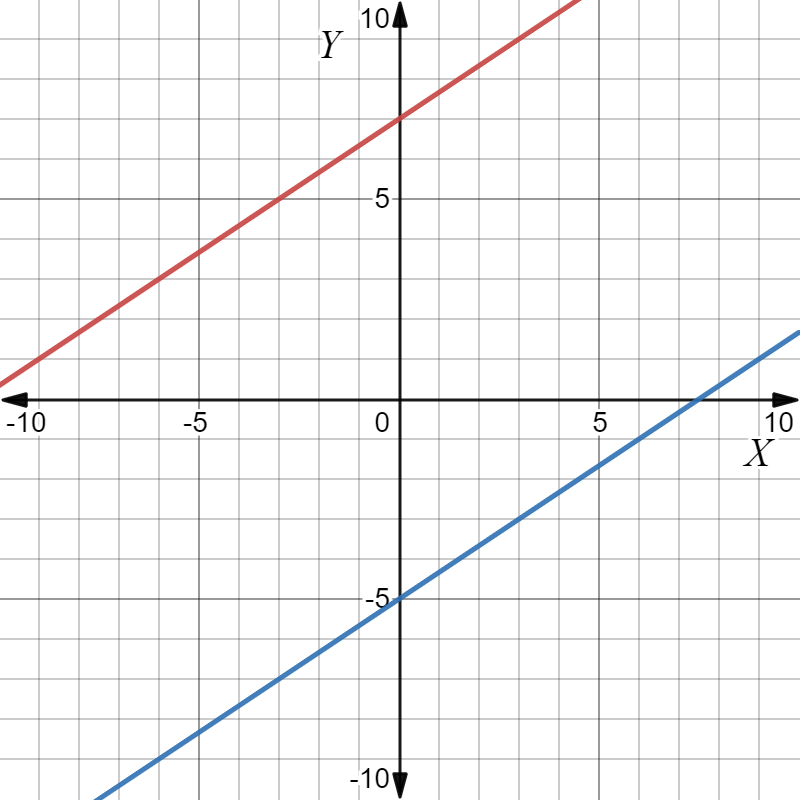
Big Ideas Math Algebra 1 Student Journal 1st Edition Chapter 5 Solving Systems Of Linear Equations Exercise 5.4 Page 151 Exercise 18 Answer
Given: The equations given are−3x+5y=15, 9x−15y=−45
To Find The equations are to be solved and the values of variables are to be found
Solution: The equations will be solved by the elimination method.
The equation −3x + 5y = 15 is multiplied by 3.
Simplifying them we get no solution as the variables are canceled.
The graph of the linear equations is:
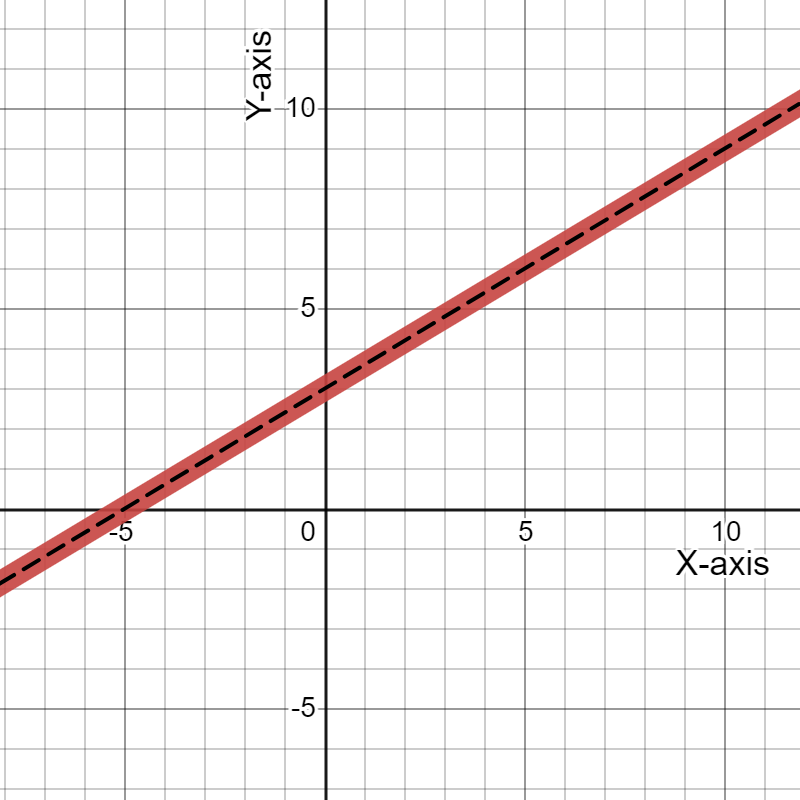
And this shows that there exists no solution.
Solving the linear equations−3x + 5y = 15,9x−15y =−45 we get that there exists no solution which is given by the graph:
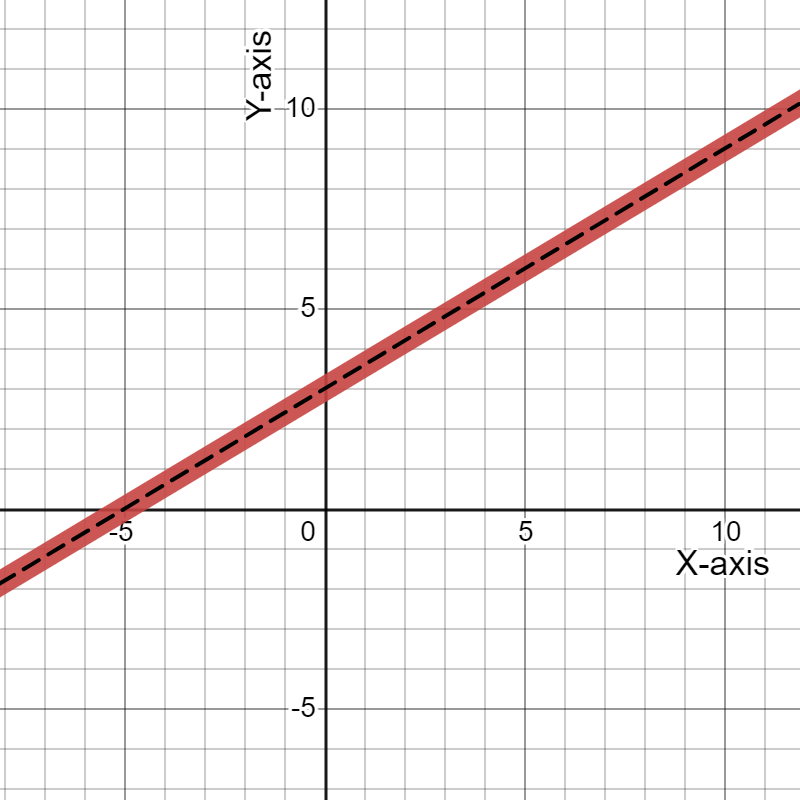
Big Ideas Math Algebra 1 Exercise 5.4 Guide
Page 151 Exercise 19 Answer
Given: Me and my friend have 15 & 25 as savings.
To FindThe linear equations for the problem are to be found, and the situation when I and my friend will have the same amount is to be found and explained.
Solution: The linear equations will be made and solved.
The equation will be 15 + 5x = y 25 + 5x = y.
Solving these we will get no solution, as the variables will be canceled.
The graph is shown as

This will show that there will be no situation wherein there will be the same amount.
The linear equations are 15 + 5x = y, 25 + 5x = y, which is plotted on the graph is shown as:
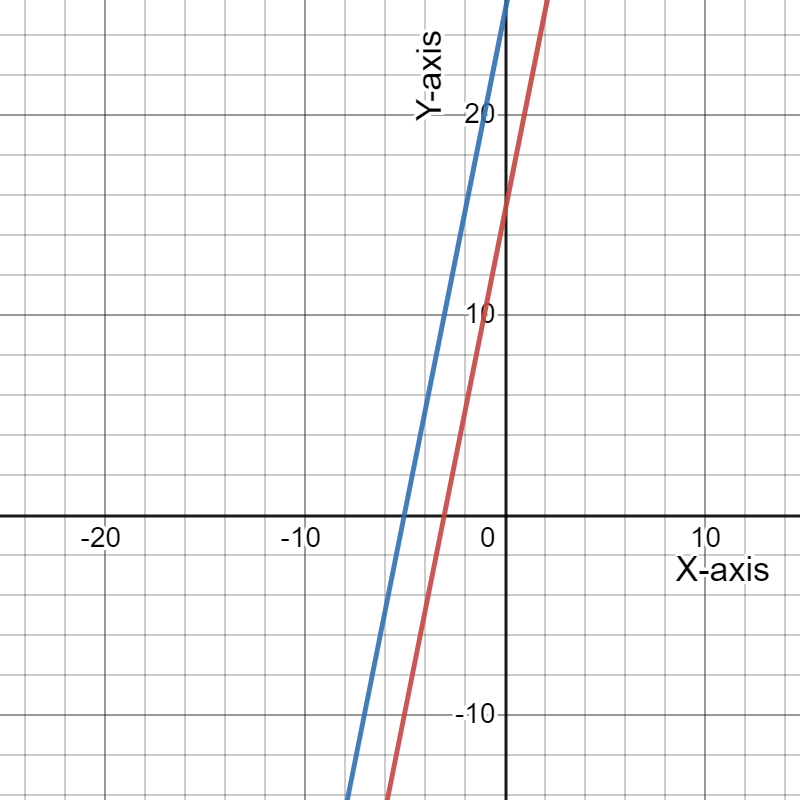
Which when solved gives no solution, and this shows that there will be any situation when there will be the same amount.
